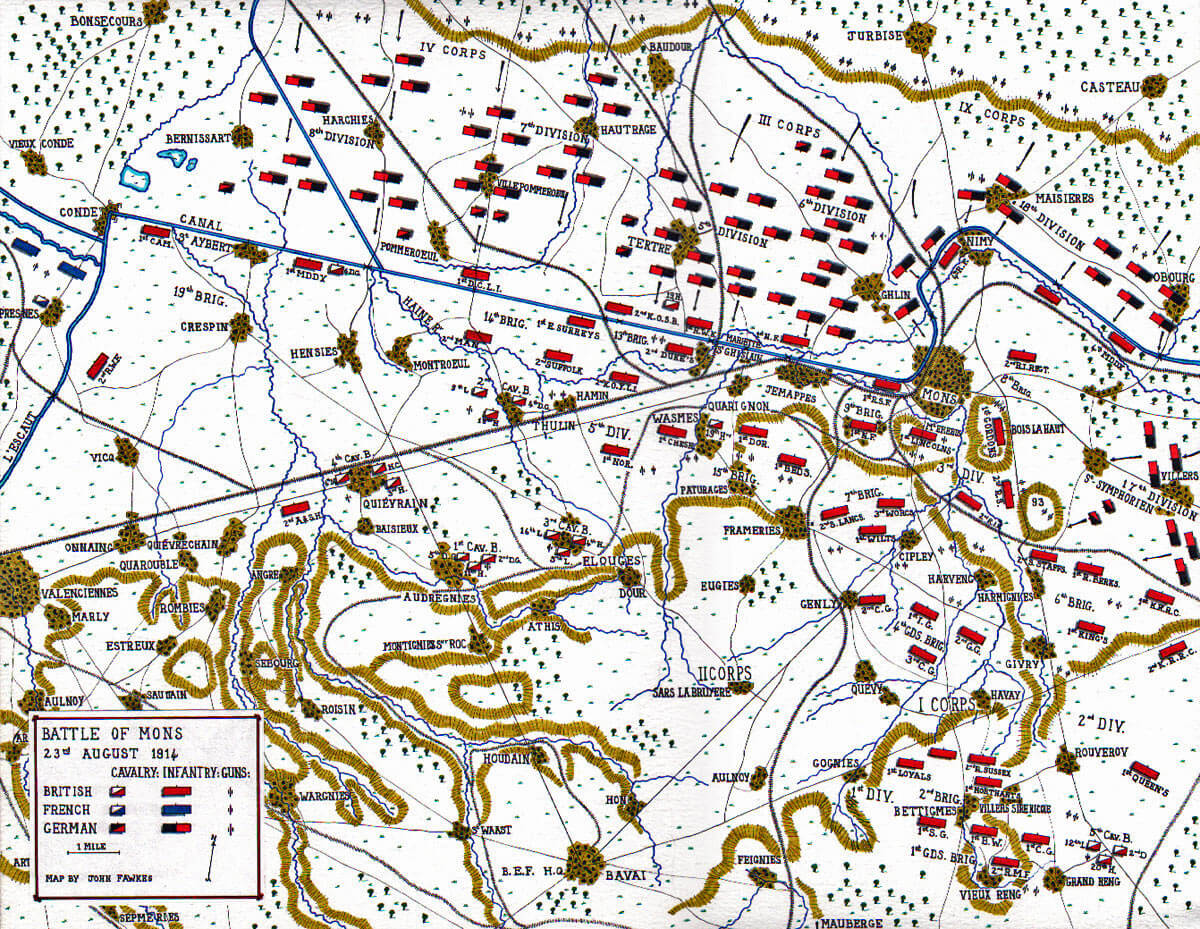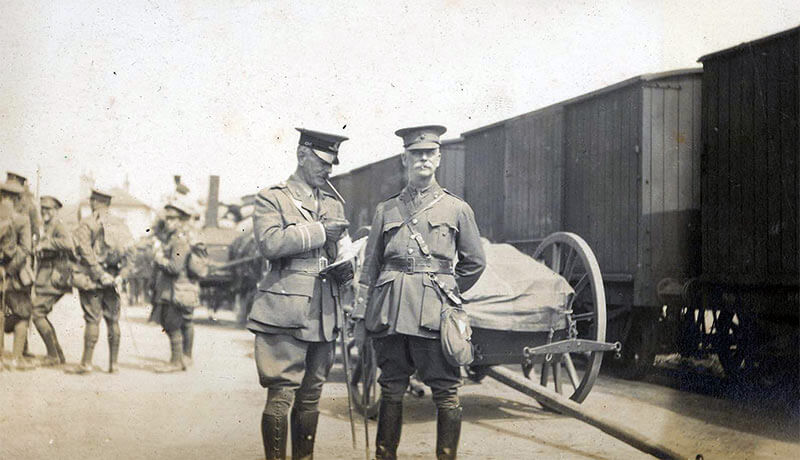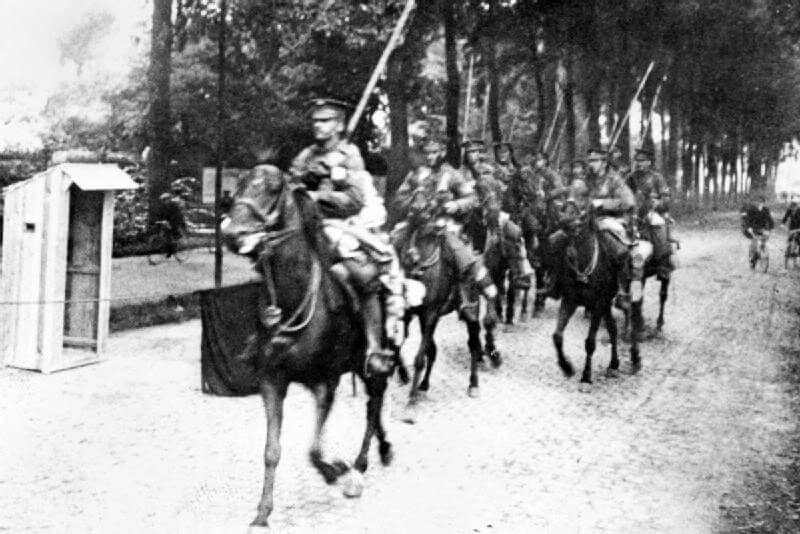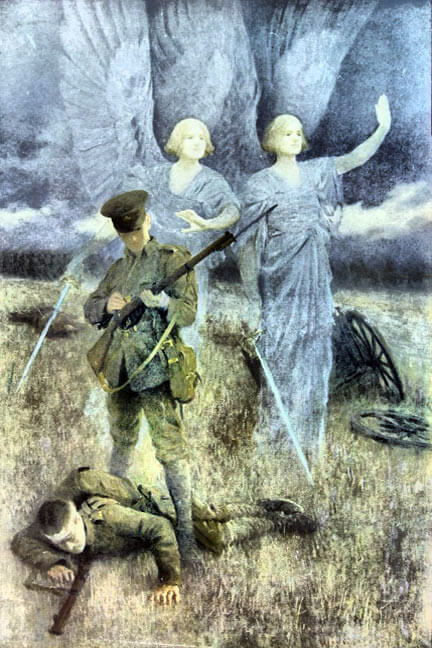The Opening Battle of the First World War for the British Expeditionary Force, fought on 23rd August 1914: Massed German infantry encountered the regulars and reservists of the British Army and received an unpleasant shock
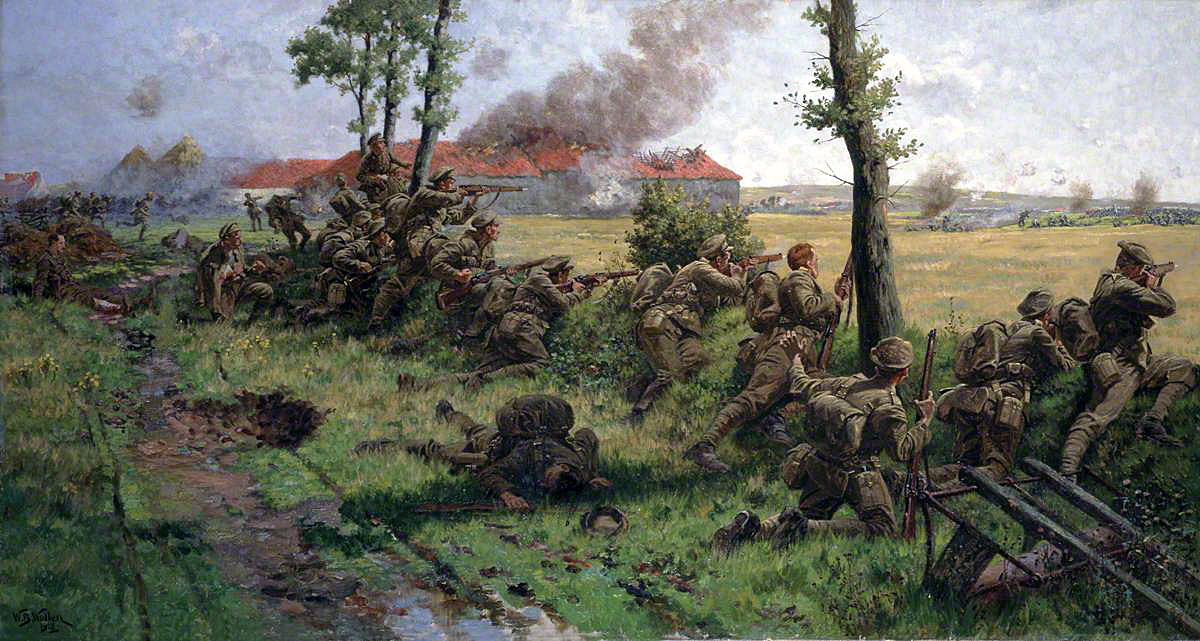
‘Our little contemptibles’: Battle of Mons on 23rd August 1914 in the First World War: picture by William Barnes Wollen
The previous battle in the First World War is the British Expeditionary Force (BEF)
The next battle in the First World War is the Battle of Mons (2nd Day): Elouges
Date of the Battle of Mons: 23rd August 1914
Place of the Battle of Mons: In Belgium on the French border
War: The First World War known as the ‘Great War’.
Contestants at the Battle of Mons: The British Expeditionary Force (BEF) against the German First Army.
Commanders at the Battle of Mons: Field-Marshal Sir John French commanding the British Expeditionary Force (BEF) with Lieutenant-General Sir Douglas Haig commanding I Corps and General Sir Horace Smith-Dorrien commanding II Corps against General von Kluck commanding the German First Army.
Size of the Armies:
The BEFcomprised 2 corps of infantry, I and II Corps, and a cavalry division; 85,000 men and 290 guns.
Both corps of the BEF and the Cavalry Division were in action, although the bulk of the fighting was carried out by Smith-Dorrien’s II Corps along the line of the Mons Canal (Le Canal du Centre or Le Canal de Condé). II Corps comprised around 25,000 men.
General von Kluck’s First Army comprised 4 corps and 3 cavalry divisions (160,000 men) and 550 guns.
Winner of the Battle of Mons:
The British were compelled to fall back to comply with the withdrawal of their French allies on their right and to avoid encirclement, leaving the Mons canal line in German hands. However heavy casualties were inflicted on the German infantry during their attacks on the British positions, although the numbers were insignificant compared with casualties in the battles later in the war.
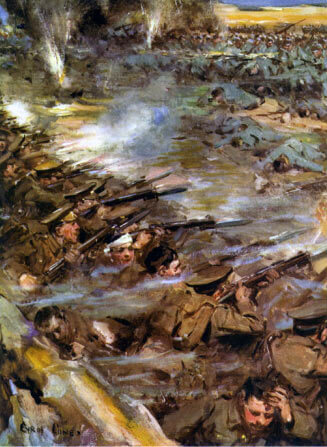
British infantry receive the German attack: Battle of Mons on 23rd August 1914 in the First World War
Armies, uniforms and equipment in the Battle of Mons:
The armies on the Western Front in the Great War from 1914 were the Germans against the French, the British and the Belgians. In 1918 the Western Allies were joined by the United States. Other nationalities took part on the side of the Western Allies on the Western Front in small numbers: Portuguese, Poles and Russians. From 1915 onwards significant numbers of Canadians, Australians, Newfoundlanders and members of the Indian Army fought in the British line of battle. The first regiments of the Indian Army arrived in the Ypres area at the end of 1914.
The Great War began in August 1914. Britain despatched the British Expeditionary Force (BEF) to France to take up a position on the left of the French armies, with its concentration area around the fortified town of Mauberge, south of the Belgian border.
At the end of the 19th and beginning of the 20th Century the British Army’s day to day task was the ‘policing’ of a worldwide empire. With increasing tension on the continent of Europe, from 1900 onwards the British Government remodelled the British army to provide a field force capable of taking part in a continental war. This force was to comprise 6 divisions of infantry and a cavalry division. Initially, in August 1914, the BEF took only 4 infantry divisions to France with the remaining 2 infantry divisions following later in the year.
In the late 1870s Edward Cardwell, the British Secretary of State for War, set up the 2 battalion regimental system which was designed to provide 1 battalion in garrison abroad with a supporting battalion at home in Britain or Ireland. Four line regiments comprised 4 battalions while the 3 old Foot Guard regiments comprised 3 battalions. The rude shock of the Boer War in South Africa between 1899 and 1901 caused the British Army to remodel its training to emphasise the importance of small arms marksmanship and weapon handling. Regular musketry courses brought skills to a level where British infantrymen were capable of firing up to 20 or 30 rounds a minute of accurate rifle fire, the standard being 12 rounds a minute. This rate of fire was to give the Germans a shock in the opening battles of the Great War and create the impression that the British were armed with many more machine guns than they actually possessed. Opening volleys at this rate were referred to as the ‘mad minute’. British cavalry also received extensive training in firearms use, enabling them to fight effectively in a dismounted role, when required.
The regular British Army comprised some 200 infantry battalions and 30 cavalry regiments. The Royal Artillery comprised batteries of field and horse artillery. The Royal Garrison Artillery manned the heavy 60 pounders guns.
As part of the army reforms the old concept of ‘service for life’ was abandoned. Soldiers served 7 years with the colours, with the option of extending to 14 years, rarely taken up other than by successful non-commissioned officers, and then 7 years service in the reserve after the soldier returned to civilian life. The home battalions were heavily under manned as recruitment into the army was always inadequate. With the outbreak of the Great War units filled up with reservists who made up a substantial proportion of most battalions and cavalry regiments, in some cases up to 70%.
The rifle carried by British troops, both infantry and cavalry, was the .303 Lee Enfield bolt action magazine rifle. The Lee Enfield was a robust and accurate weapon that continued in service with the British Army until the 1960s.
The British Royal Field Artillery was equipped with the 18 pounder quick firing field gun and the Royal Horse Artillery with the smaller equivalent 13 pounder gun, both effective weapons remaining the mainstay of British field artillery for the rest of the Great War.
The Royal Field Artillery also operated field batteries armed with the 4.5 inch howitzer.
The British heavy gun operated by the Royal Garrison Artillery was the 60 pounder. The British Army lacked heavier guns comparable with the weapons used by the Germans and the French during the early period of the war.
Each British infantry and cavalry regiment was issued with 2 machine guns. These weapons immediately dominated the Great War battlefield.
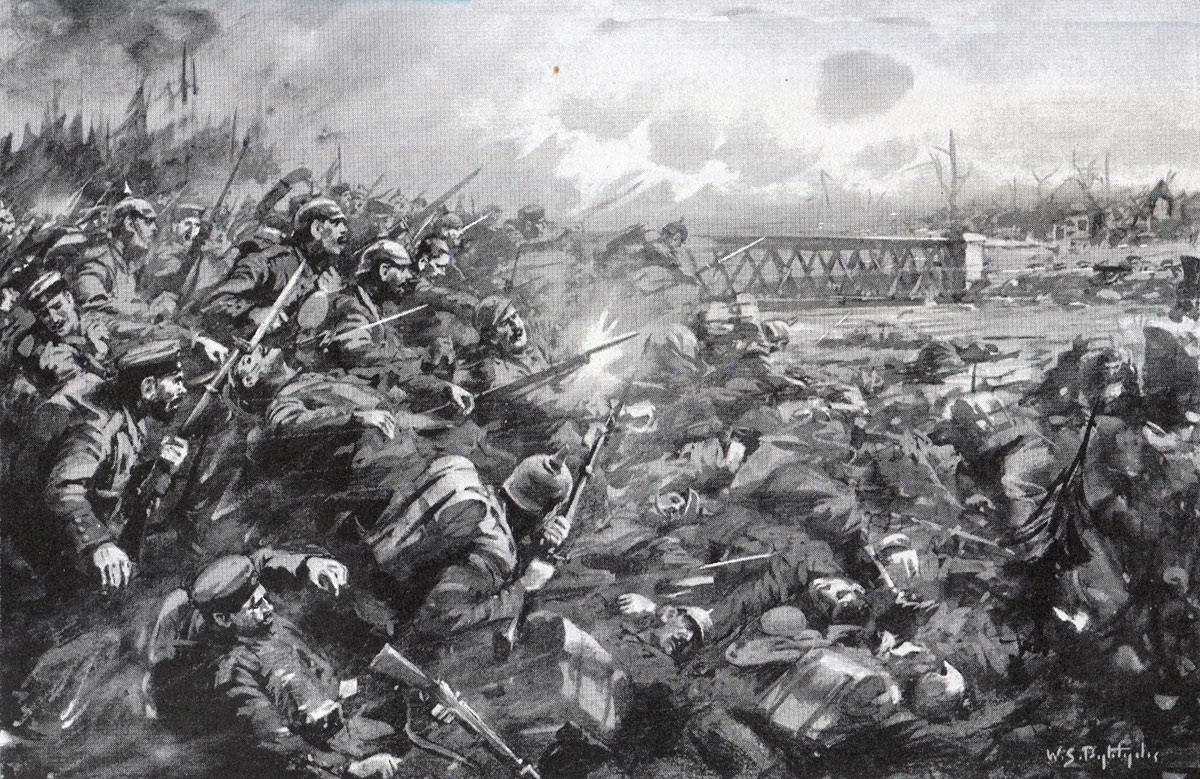
German attack on the Nimy Bridge at the Battle of Mons on 23rd August 1914 in the First World War: picture by W.S. Bagdatopoulos
The German Army at the Battle of Mons:
War between France and Germany was considered inevitable following the annexation of Alsace and Lorraine by Germany after the Franco-Prussian War in 1870 to 1871. The armies of each country were from 1871 onwards organised with such a war in mind. With the pact between France and Russia it was clear that Germany, with its ally Austria-Hungary, would have to fight on an eastern front against Russia as well as the western front against France.
The German Army was formed on the same basis as all the main European armies, with a force at the colours to be massively augmented by reservists on mobilisation. These reservists served with the colours and then joined the reserve on return to civilian life. On mobilisation the German army increased to a force of around 5 million men, while the French army comprised around 3 million men.
Full-time military service in Germany was universal for males and comprised 2 years with the colours or 3 years in the cavalry and horse artillery. There was then 5 or 4 years service in the Reserve followed by 11 years in the Landwehr. The army was organised into 25 active army corps each of 2 divisions and a number of reserve corps and divisions in support of the active formations. There were 8 cavalry divisions, each with jäger infantry supporting units.
The German armaments company of Krupps supplied the German army with a range of highly effective artillery of all weights. Machine guns were widely issued. The German army was well advanced in radio communication and in the use of airplanes for reconnaissance and artillery spotting.
It is clear that none of the armies involved in the war at this early stage anticipated the impact of the modern weapons they were deploying and in particular the impact of machine guns and concentrated artillery fire.
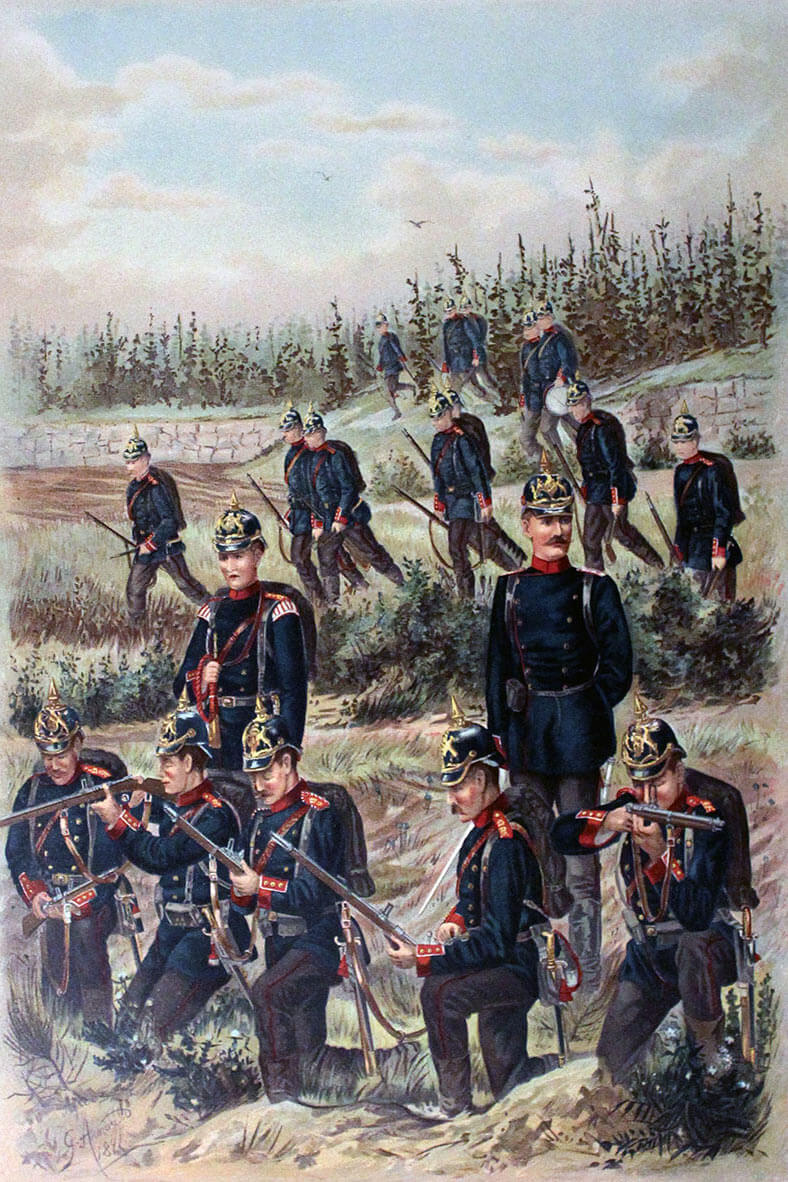
125th Würtemberg Infantry Regiment of the German Army during exercises in around 1905: Battle of Mons on 23rd August 1914 in the First World War: illustration by Major General von Specht
Background to the Battle of Mons:
The trigger for the Great War, or First World War, was the murder of the heir to the Austrian throne, Arch-Duke Ferdinand, and his duchess in Sarajevo on 28th June 1914 by Gavrilo Princip, a member of a gang of Serbian Nationalists who objected to the annexation of Bosnia-Herzegovina by Austria. Reacting to the assassination, Austria declared war on Serbia, following which Russia declared war on Austria in support of their fellow Slavs in Serbia. In accordance with its treaty with Austria, Germany declared war on Russia and in accordance with its treaty with Russia, France declared war on Germany.
It was apparent from the outset of the Great War that the principal theatres of war would be the Western Front between France and Germany and the Eastern Front between Germany and Austria and Russia. The Austrian campaign against Serbia was of less significance militarily although important symbolically.
General von Schleiffen in the 1890s devised the German plan for invading France. The Schleiffen plan provided for a line of German formations wheeling through Belgium, outflanking the French armies by marching around the west side of Paris, while other German units held the French armies in a line from the Swiss frontier to the Belgian border.
Once it was clear that the Germans were invading Belgium, Great Britain declared war on Germany and Austria. In the period from 1900 to 1914 Britain and France had developed the ‘Entente Cordiale’ on the assumption that the 2 countries would be fighting Germany as allies, although no formal pact was entered into.
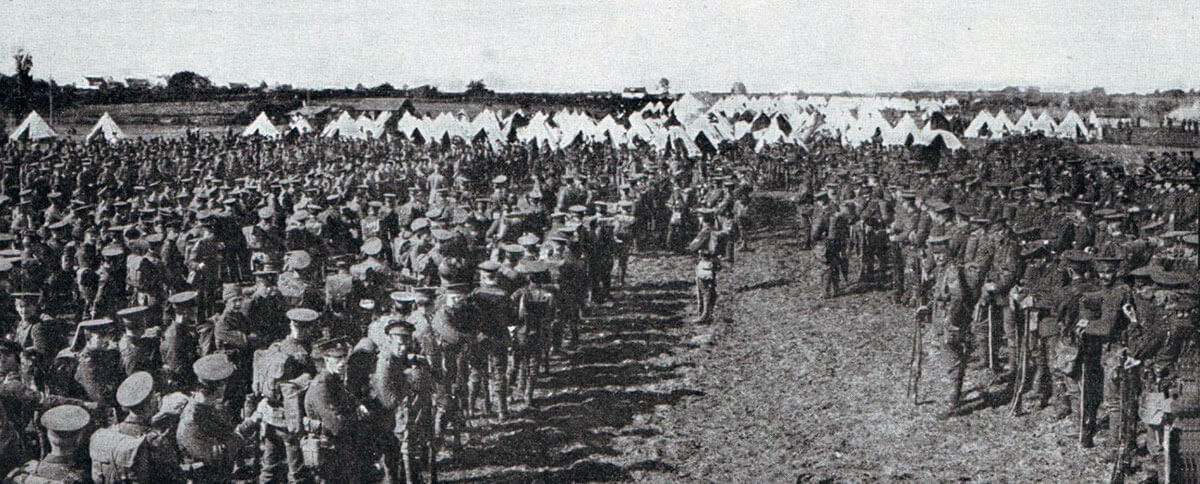
British infantry, before moving up to the front line: Battle of Mons on 23rd August 1914 in the First World War
Each nationality at the outset of the war seems to have had the expectation that the war would be finished by Christmas 1914 with their own victory. One of the few to foresee that the war would be long and hard fought was Lord Kitchener, appointed British Minister for War on 6th August 1914.
Russia began its mobilisation on 29th July 1914. France and Germany began their mobilisation on 1st August.
At the outbreak of war the German Commander in Chief was the Kaiser, Wilhelm II. The actual commander was General von Moltke, the German Chief of Staff. The German strategic plan was to take advantage of the slowness of Russian mobilisation to commit the preponderance of German forces against France and to switch them to the Eastern Front once France was defeated. The Germans expected the defeat of the French to be quickly achieved. The speed of the Prussian defeat of France in 1870 led the Germans to believe the same could be achieved in the next war.
While nominally applying the Schlieffen Plan von Moltke made a significant change. The change was that the wheeling German armies would pass to the east of Paris, not to the west as von Schlieffen intended. This would have the consequence that the German right wing would not be able to swing well clear of the French left flank.
It was von Schlieffen’s intention that the armies on the German left, well away from the Paris envelopment, would give ground and not make any attempt to push back the French forces opposing them. This important element of the plan was also abandoned in the face of clamours from the commanders on the German left wing to be permitted to attack the French and push them back.
Germany declared war on France on 3rd August 1914. On the next day German troops crossed the border into Belgium. In the light of Germany’s invasion of Belgium, Britain declared war on Germany the same day and began mobilising.
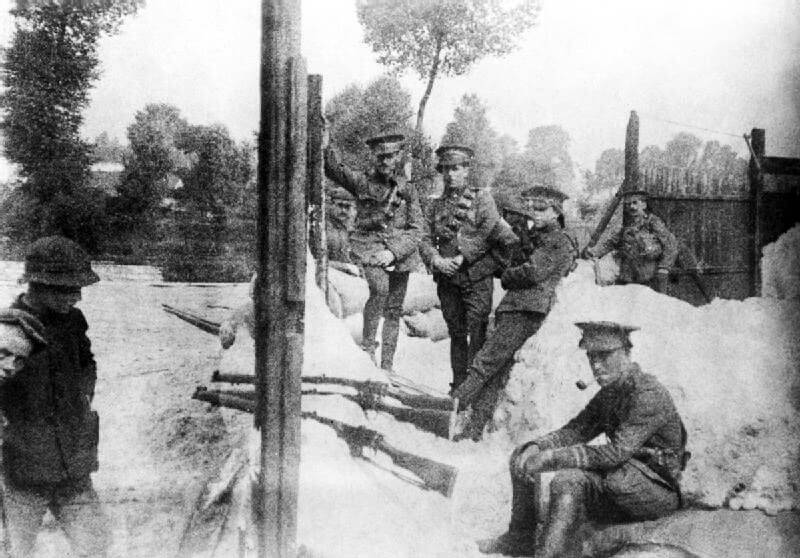
4th Dragoon Guards on the Mons Canal waiting for the infantry to take over their positions: Battle of Mons on 23rd August 1914 in the First World War
On 6th August 1914 the decision was taken to send the British Expeditionary Force (BEF) to France, comprising 2 Corps and a cavalry division commanded by Field-Marshal Sir John French. I Corps commanded by Lieutenant-General Sir Douglas Haig comprised 1st and 2nd Divisions. II Corps commanded by Lieutenant-General Sir John Grierson comprised 3rd and 5th Divisions. The Cavalry Division was commanded by Major-General Allenby. 4th Division would remain in Britain and the 6th Division would remain in Ireland, for the time being.
A significant element of the Royal Flying Corps accompanied the BEF and from an early date provided useful information from reconnaissance flights on German movements. This information was often insufficiently exploited by the higher command in the early period of the war.
There was no commitment in France of the British Territorial Force, which comprised full regiments of part-time soldiers, in the first weeks of the War, although they were soon sent to France to act as line of communication troops and were thrown into the fighting around Ypres at the end of 1914. Lord Kitchener had an antipathy to the Territorial Force regiments and chose later to raise completely new battalions as ‘Kitchener’s Army’.
Units from the Indian Army arrived in France later in 1914 in time for the ‘Race to the Sea’, which ended in the savage fighting around Ypres.
The advanced party of the BEF crossed to France on 7th August 1914 and the BEF itself crossed to the French ports of Le Havre, Rouen and Boulogne between 12th and 17th August and moved forward to its concentration area between Mauberge and Le Cateau, near the Belgian border, where it was assembled by 20th August.
On 16th August 1914 the Germans captured Liége after an heroic defence by the Belgian Army.
On 19th August 1914 the German Kaiser commanded the destruction of Britain’s ‘Contemptible little army’ (The translation from the German might also allow ‘Contemptibly little army’. Bismarck, the German Chancellor in the 19th Century had memorably said that ‘If the British Army lands of the coast of Germany I will send a policeman to arrest it.’)
The Germans expected the BEF to land in the area of Calais before moving in a south-easterly direction and von Kluck’s First Army was deployed to meet this threat. The German navy informed the German army command shortly before the Battle of Mons that the British had not yet landed in France. Von Kluck was unaware that the BEF lay in the path of his advance south into France.
The French Army formed between the borders of Switzerland and Belgium, in order from right to left: First Army, Second Army, Third Army, Fourth Army and Fifth Army (under Lanrezac). The BEF was expected to come up on the left flank. The French Cavalry Corps (under Sordet) moved into Belgium.
The French Commander-in-Chief was General Joffre. The BEF was not subordinated to the French Command but was expected to co-operate with it. The relationship between the British Commander-in-Chief, Sir John French, and General Joffre was ill-defined and unsatisfactory.
In preparation for the execution of the Schlieffen Plan the German armies were formed up with their First Army under von Kluck on the right, advancing through Belgium; Second (under Bulow) and Third (under Hausen) Armies also advancing through Belgium; Fourth Army advancing on Sedan; Fifth Army advancing on Verdun from Thionville and Metz; with Sixth and Seventh Armies in Southern Lorraine holding the left wing up to the border of Switzerland.
The 3 Armies on the Western Front exercised different policies in relation to their reserve troops. The British policy is set out above. The reservists filled out existing regular formations. For the French and German armies reservists completed regular formations but also formed reserve units up to divisional and corps strength. The French did not intend to rely upon these units and kept them well back in reserve.
The Germans in contrast put their reserve units into the fighting line with the result that they deployed a substantially stronger force than the French, even with their commitments on the Eastern Front.
Account of the Battle of Mons:
On 17th August 1914 Lieutenant-General Sir John Grierson, commanding the British II Corps, died of a heart attack on a train in France. His command was taken over by General Sir Hubert Smith-Dorien DSO from 22nd August.
On 20th August 1914 Sir John French, the British Commander-in-Chief, reported to General Joffre, the French Commander-in-Chief, that the concentration of the BEF was complete.
Matters were not going well for the French Army. The French First and Second Armies suffered severe reverses at the hands of the German Sixth and Seventh Armies on the far right of the French line.
The BEF moved forward towards the Belgian border on 22nd August 1914. Sir John French’s intention was to establish a defensive line along the high road from Charleroi to Mons with the French on the BEF’s right. This proved impracticable as the German movement to the BEF’s left occupied Charleroi and the French Fifth Army under Lanrezac fell back on the right. The BEF took up positions with the British II Corps along the line of the Mons canal and I Corps on the right, angled back from the line of the canal.
As the BEF moved up into position in the area of Mons the Cavalry Division provided a screen in front of the advancing infantry divisions.
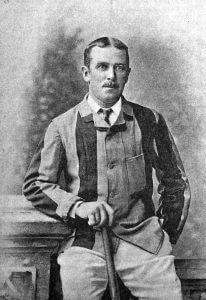
Captain Hornby, 5th Dragoon Guards, a successful polo player in India before the war: Battle of Mons on 23rd August 1914 in the First World War
22nd August 1914:
The British cavalry covered the gap between the 2 British infantry corps to the east of Mons. A squadron of the 4th Dragoon Guards commanded by Major Tom Bridges was the first British unit into action. Bridges’ men encountered German cavalry of the 4th Cuirassiers on the road north of Obourg. The Germans withdrew pursued by Lieutenant Hornby with 2 troops. Hornby caught up with the cuirassiers near Soignies, which lies to the north east of Obourg and does not appear on the map, and after a brisk fight forced them into flight. The pursuing British Dragoon Guards were brought up short by fire from a regiment of German Jӓgers. The British dismounted and returned fire until Bridges received orders to return to his regiment and the fight ended. The squadron of the 4th Dragoon Guards arrived in the brigade lines with captured German soldiers, horses and equipment to the cheers of the brigade. Lieutenant Hornby received the DSO.
At the left end of the British line a squadron of the 19th Hussars, the divisional cavalry of the 5th Division, and a company of cyclists engaged the advancing German cavalry at Hautrage all day.
Other British cavalry regiments, the Scots Greys and 16th Lancers, engaged the German cavalry screen.
During the night of 22nd August 1914 the Cavalry Division, less the 5th Cavalry Brigade, moved across to the left flank of II Corps to the area of Thulin-Elouges-Audregnies, a march of around 20 miles. The 5th Cavalry Brigade remained with Haig’s I Corps on the right of the BEF.
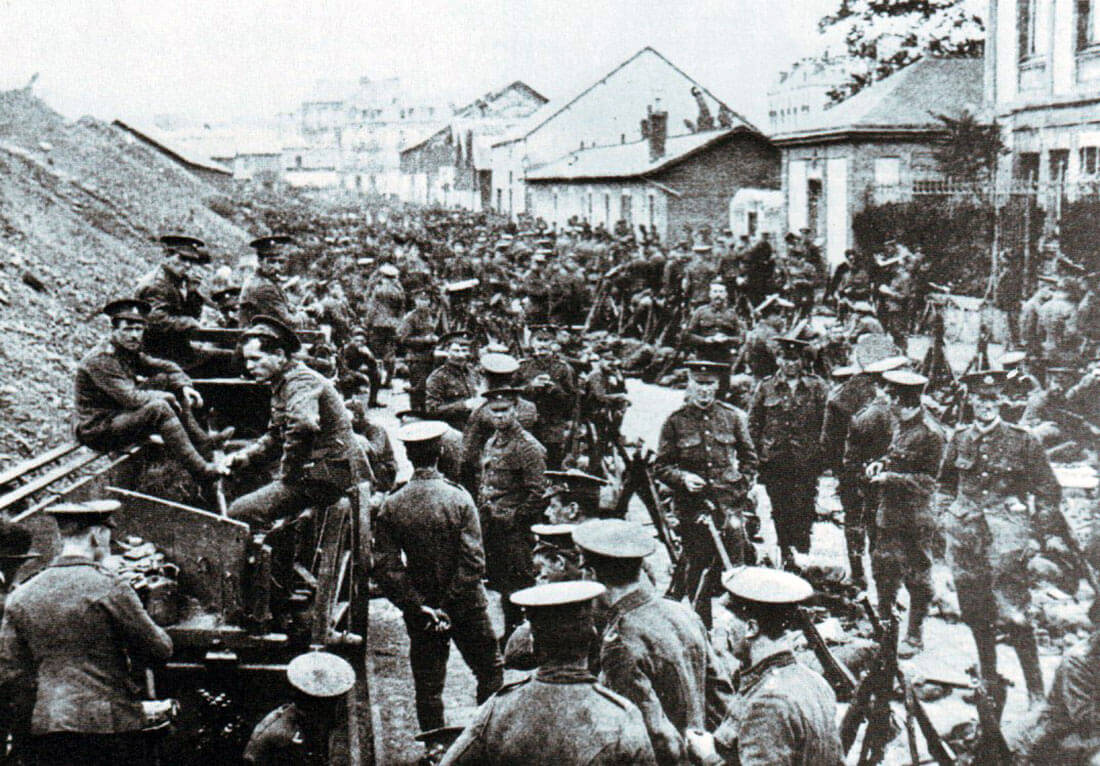
British infantry waiting to advance in the Mons area: Battle of Mons on 23rd August 1914 in the First World War
The Mons positions:
The Mons Canal (‘Le Canal du Centre’ or ‘Le Canal de Condé’) runs from Charleroi on the Sambre River in the east to Condé on the Scheldt or L’Escault River. For the section from Mons to Condé the canal follows a straight line running east to west. To the immediate east of Mons the canal forms a semi-circular bulge or salient to the north, with the village of Nimy at the north west of the bulge and Obourg on the north east side.
The Mons canal ran through what was in 1914 an important coal mining area and its route was, in the area occupied by the BEF, almost continuously built up and covered with small enclosures, pit-heads and slag heaps for a mile or so to either side of the canal. There were some 12 bridges and locks in the length of the canal between Condé and Obourg, including 3 bridges in the salient, a railway and a road bridge at Nimy and a road bridge at Obourg.
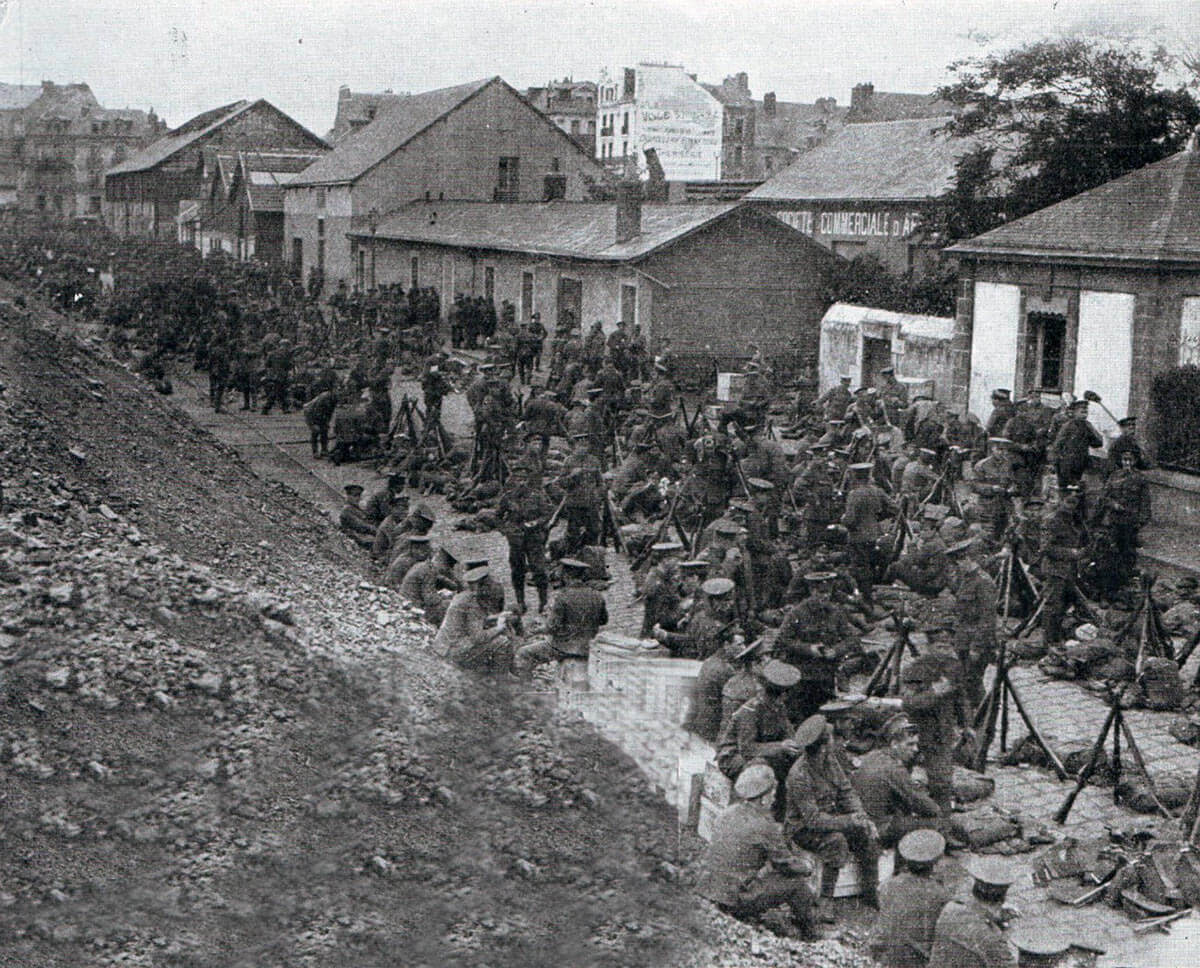
British infantry waiting to move forward in the Mons area: Battle of Mons on 23rd August 1914 in the First World War
During 22nd August 1914 the British II Corps moved up to the section of the Mons Canal between Obourg and Condé, 3rd Division taking the right flank with 5th Division on its left.
Of the 3rd Division; the 8th Brigade occupied the area on the east side of the canal salient and to its south, with the battalions from the right: 2nd Royal Scots, 1st Gordon Highlanders, both in position to the south east of the canal, the Gordons occupying a feature of high ground call Bois La Haut with the Royal Scots as the connecting battalion to I Corps; 4th Middlesex lined the canal in the area of Obourg, with 2nd Royal Irish Regiment in reserve.
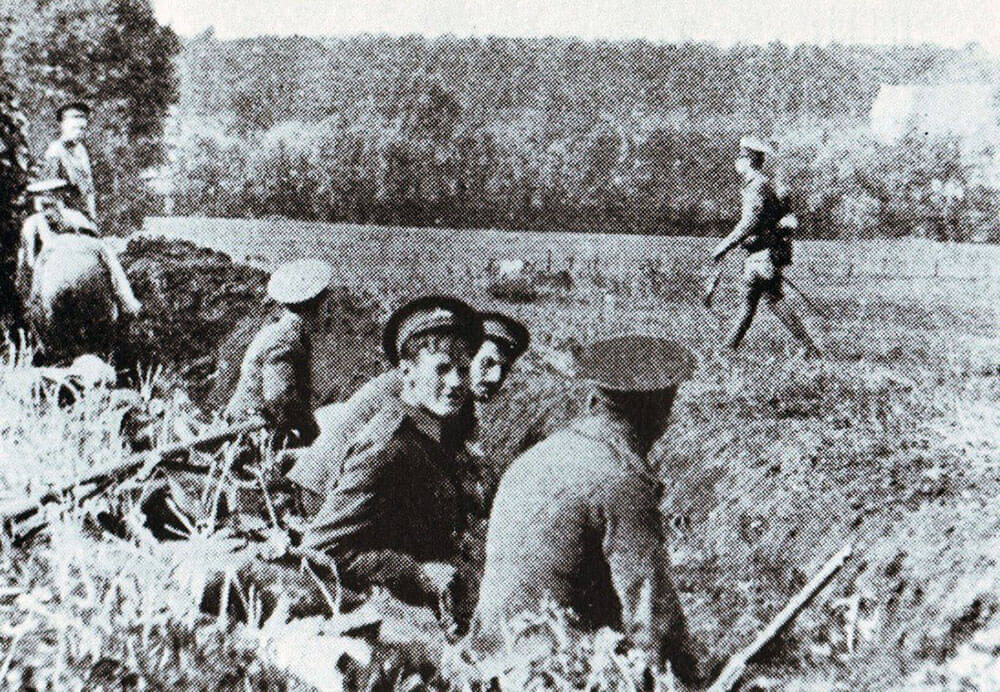
Soldiers of the 1st Lincolns in position to the south of Mons: Battle of Mons on 23rd August 1914 in the First World War
The 9th Brigade lined the canal salient through Mons with the battalions in line from the right: 4th Royal Fusiliers, 1st Royal Scots Fusiliers (1st RSF) and 1st Northumberland Fusiliers with 1st Lincolns in reserve.
The 13th and 14th Brigades of the 5th Division lined the Mons Canal extending the BEF’s position to the west. From the left flank of 3rd Division: 13th Brigade comprising 1st Royal West Kents (1st RWK) and 2nd King’s Own Scottish Borderers (2nd KOSB) with 2nd King’s Own Yorkshire Light Infantry (2nd KOYLI) and 2nd Duke of Wellington’s Regiment (2nd DWK) in reserve. 14th Brigade: 1st East Surreys positioned north of the canal, 2nd Manchesters and 1st Duke of Cornwall’s Light Infantry (1st DCLI) along the canal with 2nd Suffolks in reserve.
On the left of 5th Division the independent 19th Brigade came up to the Mons Canal during the 23rd August with, in line from the right; 2nd Royal Welch Fusiliers (2nd RWF), 2nd Middlesex and 1st Cameronians with 2nd Argyll and Sutherland Highlanders (2nd ASH) in reserve. This brigade joined the 6th Dragoon Guards, Carabineers, on the canal.
The 7th Brigade formed the II Corps reserve in the area of Cipley.
Of the British I Corps, the 1st Division occupied positions along the Mons-Beaumont Road and the 2nd Division held positions at Harveng (4th Brigade), Bougnies (5th Brigade) and Harmignies (6th Brigade).
Several authorities, including Brigadier Edmonds in the ‘Official History of the War’, describe the British positions on the Mons Canal as an ‘outpost line’, stating that the intention was to hold positions on the higher and more open ground a mile or so to the south of the canal.
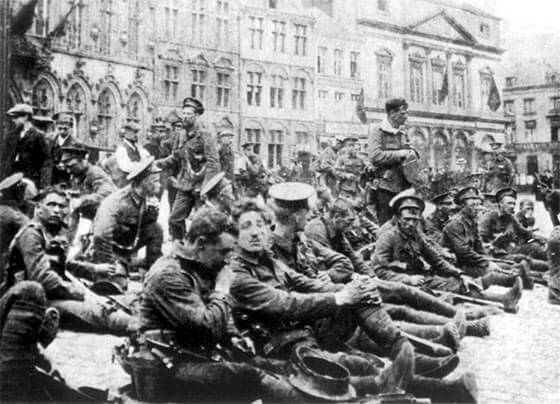
A Company, 4th Royal Fusiliers in the market square of Mons on 22nd August 1914, the day before the Battle of Mons. Soon after this photograph was taken the battalion moved up to the Mons Canal line at Nimy
The British battalions that moved up to the canal ‘dug in’ with varying degrees of success. It is apparent that it was the high command’s intention to use the canal as an obstacle to the German advance. The Royal Engineers were ordered to sink all barges in the canal and to prepare the bridges for demolition.
There were some 12 or more bridges and locks in the section of the canal covered by the British line and this was a difficult order to comply with in the few hours available. In the confusion of the advance some important demolition stores were missing. The Sappers did what they could in the circumstances.
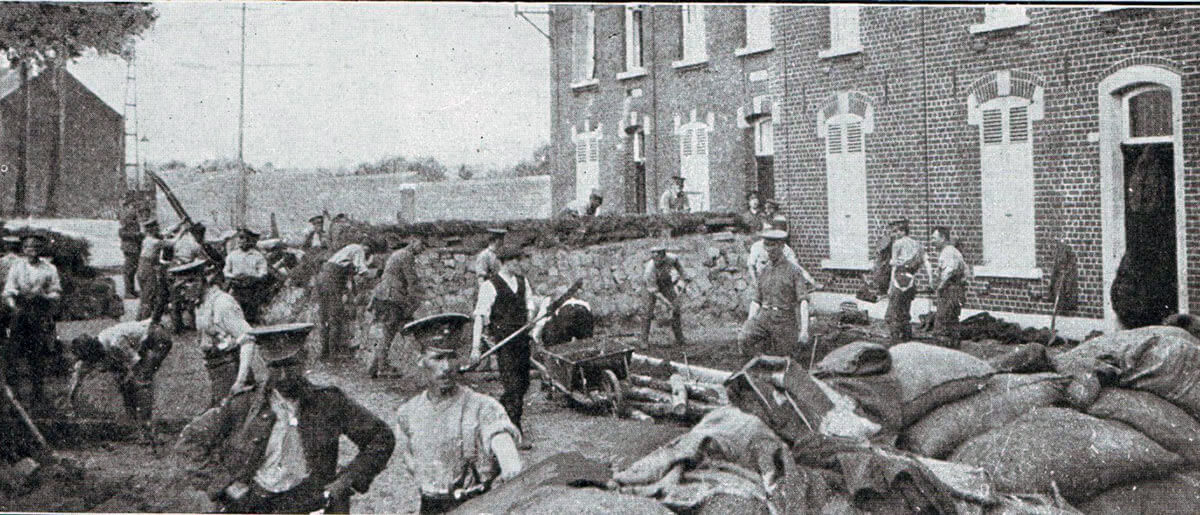
Soldiers of 1st Northumberland Fusiliers preparing street barricades in the Mons area before the fighting started on 23rd August 1914
While the Royal Engineers worked on the canal the infantry and gunners did their best to turn a confused suburban industrial landscape into a workable defensive line with positions both north and south of the canal. The artillery batteries in particular found it hard to find positions for their guns with a reasonable field of fire and to establish practicable observation posts. It was assumed that the numerous slag heaps must provide good vantage points, but the numbers of them interfered with sight lines and many were found to be too hot to stand on.
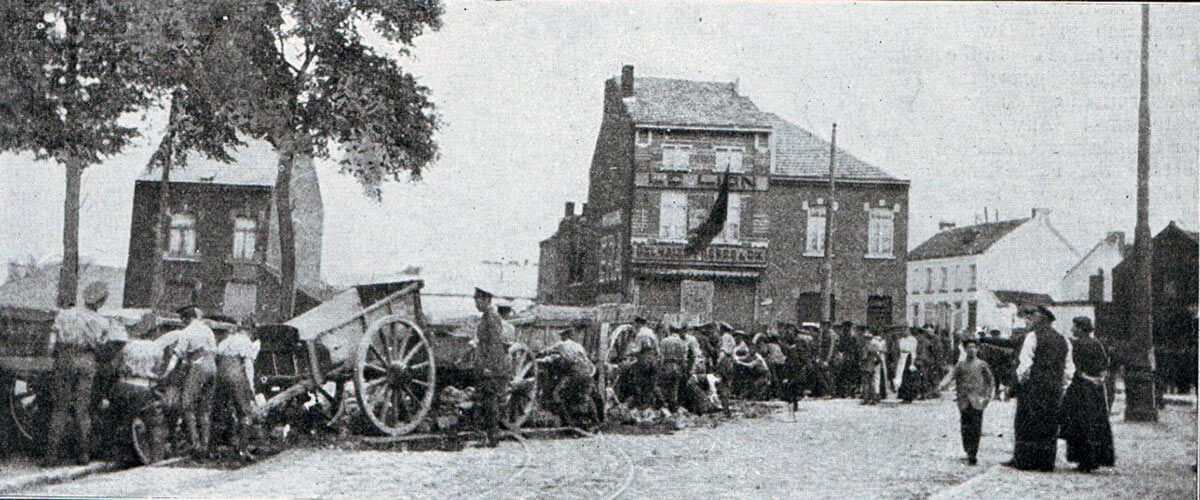
Soldiers of 1st Northumberland Fusiliers preparing street barricades in the Mons area before the fighting started on 23rd August 1914
A curious and sad feature was that the Belgian population was largely unaware that their home was about to be turned into a battlefield. 23rd August 1914 was a Sunday and began with ringing of bells, much of the population hurrying to church, with trains bringing in holiday makers from the cities. Many of these civilians were caught up in the day’s fighting.
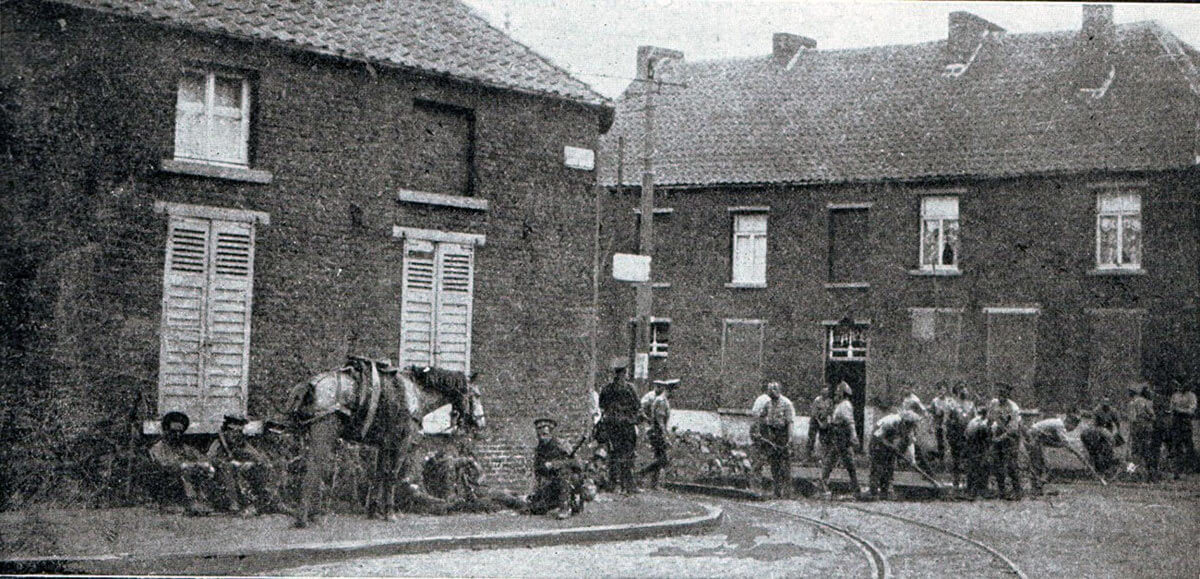
Soldiers of 1st Northumberland Fusiliers preparing street barricades in the Mons area before the fighting started on 23rd August 1914
23rd August 1914:
The opening episodes of the battle were confused by the lack of knowledge each side possessed of the deployment of the other. Von Kluck’s First Army marched through Belgium in a south westerly direction at a speed that gave it little time to assess the situation in its path. It seems that the German High Command was unaware that the British were in the line in front of them, assuming that the BEF was still not in France, although Von Kluck’s orders to First Army for 23rd August state that a British cavalry squadron had been encountered and a British airplane shot down and captured.
As the BEF advanced north from its assembly area around Mauberge cavalry patrols and reconnaissance flights by the Royal Flying Corps warned of large German troop concentrations, but the reports that the BEF II Corps with 3 divisions was about to be attacked by 6 infantry and 3 cavalry divisions of von Kluck’s First Army appear to have been discounted by Sir John French.
The German forces advancing on the Mons Canal line comprised the German 3rd, 4th and 9th Corps with the 9th Cavalry Division from the German 2nd Cavalry Corps; all of von Kluck’s First Army. That was 3 corps with cavalry from another advancing on Smith-Dorrien’s II Corps. The advance by the cavalry division was across the canal to the east of Mons and the division took no part in the direct attack on the canal line.
During the 23rd August the 17th Division of von Kluck’s 9th Corps crossed the canal to the east of the salient beyond the reach of the British defensive line and attacked the Gordons holding the high ground on Bois La Haut, so that it was simply a matter of time before the canal salient became untenable by the British, regardless of the success of their action against the regiments of the German 9th Corps attacking across the canal from the north.
In one of the first incidents of the German attack on the Mons Canal line in the early hours of the morning of 23rd August 1914 a German cavalry officer with 4 troopers rode up to an outpost of 1st DCLI, ½ mile north of the canal on the road to Ville Pommeroeul, appearing out of the mist. A British sentry shot the officer and 2 of the troopers before they could get away.
The initial German assault on the canal line, by the 18th Division of the 9th Corps, fell on the canal salient north-east of the city of Mons; the point defended by the 4th Middlesex, the 4th Royal Fusiliers and the 1st RSF. Heavy German artillery fire from the high ground to the north of the canal supported the attack, with fire direction given from spotter planes flying over the battlefield, a new technique not yet adopted by the British and French. The German infantry advanced on the canal in massed formations headed by skirmishers.
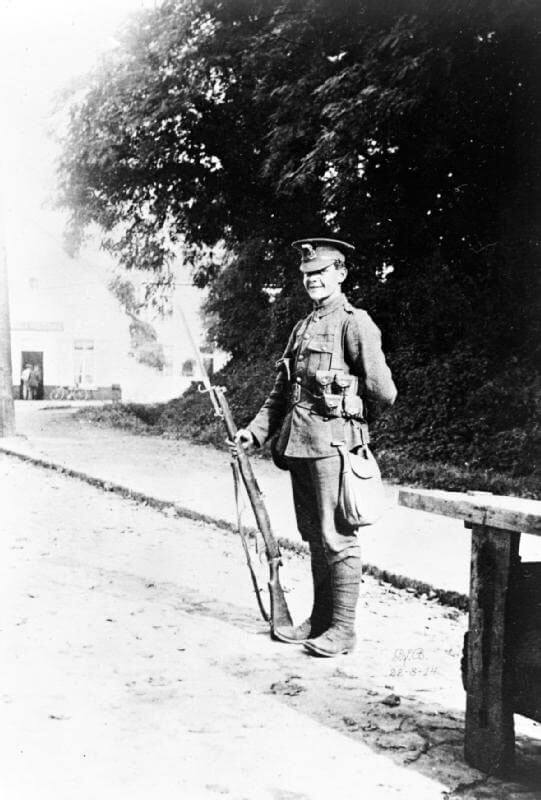
Private Carter, D Company, 4th Royal Fusiliers on sentry duty in Mons on 22nd August 1914: Battle of Mons on 23rd August 1914 in the First World War
For the first time the Germans encountered the facility with which the British troops used their rifles; the ‘Mad Minute’ in which individual soldiers could fire up to 30 aimed rounds in a minute from their .303 Lee Enfield rifles. This fire coupled with supporting machine guns decimated the advancing German formations.
The Boer War in 1899 to 1901 taught the British Army the importance of concealment when under fire and the art of concealed movement around the battlefield. The British infantrymen were in well-hidden trenches and positions in the urban landscape from which they poured a devastating fire on the advancing German infantry.
Brigadier Edmonds in the Official History of the Great War comments that British officers attending German manoeuvres in the years before the war watched the German technique of massed infantry attack and foresaw what would happen when such a form of advance was used against British infantry.
While there were clear disadvantages in attempting to defend the urban area around Mons, the canal provided the British regiments with a defensible obstacle. The canal barges and boats had been sunk by the Royal Engineer field companies. The canal was sufficiently deep to prevent the Germans from wading across so that access to the British lines could only be gained by the permanent bridges and locks or across bridging units brought up and put in place by the attacking troops, not a practicable proposition under such heavy fire. Several road and railway bridges crossed the canal and each of these became the focus of the German attacks.
The pattern of the day was repeated along the canal line from east to west; initial German attacks by massed infantry formations that were shot to pieces, followed by more careful, but increasingly heavy attacks, using open formations of infantry supported by artillery fire, that increased in weight and accuracy during the day, and by machine guns.
Artillery support was provided for the British infantry by Royal Field Artillery batteries firing 18 pounder quick firing guns positioned in sections and single guns behind the canal.
For each side these opening days of the war were the first experience of quick firing gun fire and the troops were taken aback by the all pervading effect of shell-fire. While the German guns took some time to range on the British line, once they had done so the British positions seemed to be constantly smothered by bursting shells. The myth was born of armies of civilian spies ‘spotting’ for the German batteries. It took time for the reality to be acknowledged that sophisticated artillery observation from the ground and air was directing the guns.
The initial focus of the German attack was the bridges around the canal salient; the Obourg Bridge held by the 4th Middlesex and the Nimy Bridge and the Ghlin Railway Bridge held by Captain Ashburner’s company of the 4th Royal Fusiliers, supported by the battalion’s 2 machine guns commanded by Lieutenant Maurice Dease.
On the right of the canal salient the Germans put in a series of heavy attacks on the 4th Middlesex at the Obourg Bridge. The positions around the bridge were held by Major Davey’s company with a second company under Major Abell coming up in support, losing a third of its strength in the process.
The first
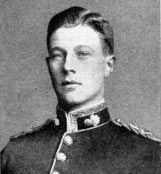
Lieutenant Maurice Dease 4th Royal Fusiliers, awarded a posthumous Victoria Cross for his handling of his machine gun at the Nimy Bridge: Battle of Mons on 23rd August 1914 in the First World War
German advance to the canal was in close company formations of the German 18th Division, presenting a good target to the Middlesex riflemen and machine guns. In the opening attacks the leading German companies were mown down as they attempted to reach the canal bridge. The Germans fell back into cover and after half an hour resumed the assault in a more open formation.
Equally heavy German infantry attacks in close columns fell on the 4th Royal Fusiliers holding the Nimy Bridge; Captain Ashburner’s company supported by 1 of Lieutenant Dease’s machine guns. These columns were decimated and the Germans fell back into the plantations along the north side of the canal. After half an hour of re-organisation the attack was renewed in more open order. While the Royal Fusiliers held the attacks the pressure increased with the build-up of German infantry and the weight of the supporting artillery fire.
Further platoons of the Royal Fusiliers came up to support Ashburner’s company, all suffering heavy casualties of officers and men. Dease continued to work his machine gun although wounded three times.
On the left of the Nimy Bridge, the Germans attacked the Royal Fusiliers on the Ghlin Railway Bridge where Private Godley manned the battalion’s second machine gun. Again the Germans suffered heavy casualties as they attempted to force the bridge. The battalion was provided with supporting fire by 107th Battery, Royal Field Artillery.
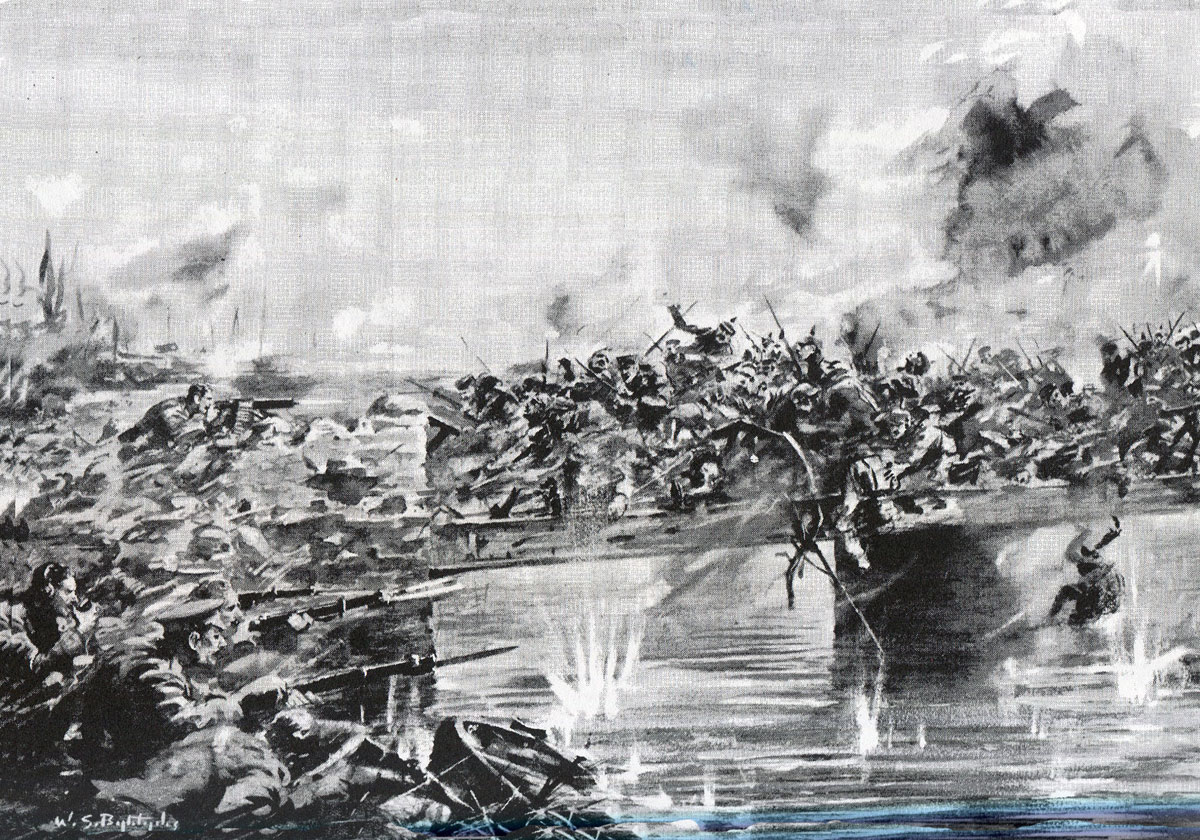
Private Godley firing his machine gun at the attacking German infantry at the Battle of Mons on 23rd August 1914 in the First World War: picture by W.S. Bagdatopoulos
To the west of Mons the German attack on the straight section of the canal took longer to develop and was less intense.
The German 6th Division launched an attack against 1st RSF and the positions of the 1st Northumberland Fusiliers on the north bank of the canal, while to the west of Jemappes the Germans advanced on the bridge at Mariette, marching up to the bridge in column of fours. The massed Germans were shot down by Fusiliers waiting in their positions to the north of the canal. The attack was renewed in a more open order but was again repelled.
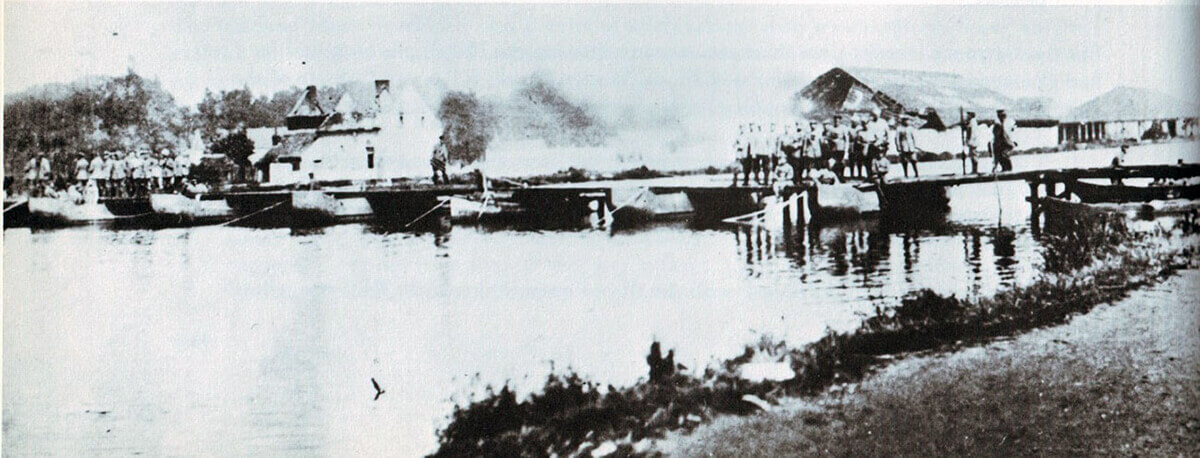
German pontoon bridge in place over the Mons Canal at Jemappes after the Battle of Mons on 23rd August 1914 in the First World War
The German infantry waited in cover while guns were brought up to fire on the Fusiliers’ positions. The German attack was then renewed. Whether deliberately or by accident a crowd of Belgian school children headed the German advance, preventing the British infantry from firing. Pressing through the children the Germans forced the Fusiliers across the canal to the south side from where the German attack was again driven back.
The next battalion to the west in the British line, the 1st RWKs, were engaged north of the Mons Canal, from where they were providing support to the divisional cavalry squadron of the 19th Hussars. The 1st RWKs eventually fell back to positions behind the canal. The attacking troops, the Brandenburg Grenadiers, then focussed on the St Ghislain Bridge but were repelled by the RWKs supported by 4 guns of 120th Battery RFA positioned on the canal tow path. The guns were forced to withdraw but the heavy fire brought down on the Brandenburgers effectively ruined the 3 battalions of the regiment.
To the west of the RWKs, the 2nd KOSB held the north canal bank, the battalion’s 2 machine guns positioned on the top storey of a house on the south side of the canal. The battalion was able to pour a heavy fire into the German infantry forming up on the edge of a wooded area on the north bank, until it was forced to fall back across the canal.
One of the regiments attacking the 2nd KOSB was the German 52nd Infantry Regiment. Once the KOSB were back on the south side of the canal this regiment delivered an attack against the railway bridge held by 1st East Surreys, advancing with 2 of its battalions in mass formation. These 2 battalions suffered the same fate as all the German mass attacks against the Mons Canal line, cut down by rifle and machine gun fire from the concealed British infantry.
By the end of the morning the 8 British battalions engaged along the Mons Canal were still in place in spite of the efforts of 4 German divisions.
Around midday the Germans infantry began to attack along the whole line of the straight section of the canal west of Mons, sworking their way forward using the numerous fir plantations and villages as cover.
At around 3pm the British 19th Brigade arrived by train at Valenciennes and came up to occupy positions at the western end of the canal line, taking over from the single cavalry regiment, 6th Dragoon Guards (the Carabineers). Soon afterwards the German attack increased in intensity.
The main area of crisis for the BEF in the day’s fighting was the Mons salient where the British battalions were subject to attack and fire from front and flank, although the main influence on the future deployment of the BEF was the increasing withdrawal of Lanrezac’s Fifth French Army on its eastern flank.
At around midday the German IX Corps redoubled its attacks on the Mons Canal salient, its artillery bombarding the British from positions to the north and east of the line. The German 17th Division after crossing the canal to the east of the canal salient, beyond the reach of the British defences on the canal line, attacked the 1st Gordons and the 2nd Royal Scots positioned to the south of the canal and facing east. The attack was driven back but the increasing threat was clear.
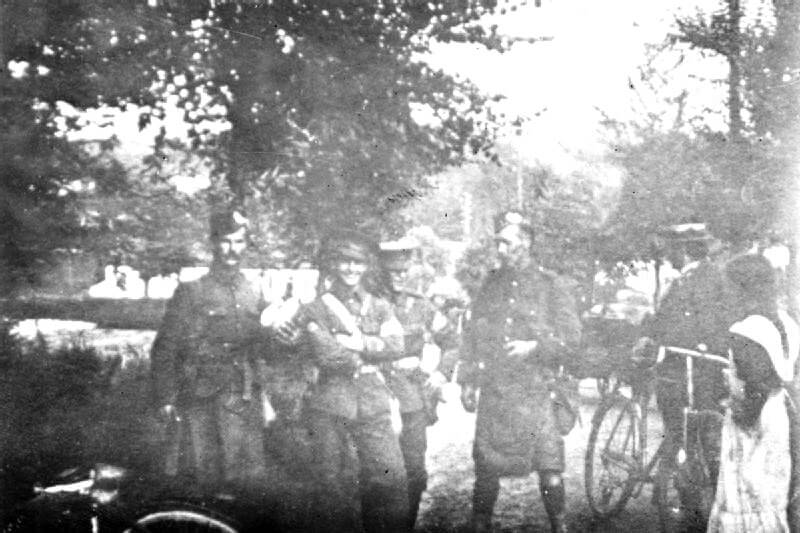
Soldiers of 1st Gordon Highlanders and 2nd Royal Irish Regiment at Mons on 22nd August 1914: Battle of Mons on 23rd August 1914 in the First World War
The Germans, now over the canal in strength, were threatening the flank and rear of the 4th Middlesex. The 2nd RIR were ordered to move up to support the Middlesex. They did so, but any movement in the canal salient was difficult due to the heavy German artillery fire and it took them some time to work their way forward. The RIR’s machine gun section dispersed a German cavalry attack but was then wiped out by gunfire.
It was clear that the BEF II Corps could no longer maintain a position along the canal with the Germans crossing the canal to the east of the British line, the French Fifth Army falling back on the British right and the Germans advancing on the BEF’s left. Orders were issued to II Corps to withdraw to the positions prepared to the south of Mons and behind the Haines River.
At around 3pm the Middlesex and the RIR began to withdraw from the canal salient. The Royal Fusiliers and the RSF were already doing so. The withdrawal of the Royal Fusiliers was covered by the wounded Private Godley still firing his machine gun on the railway bridge. When it was time for Godley to follow the withdrawal he broke up the machine gun and threw the pieces in the canal. Godley crawled to the road and lay there until he was taken to the Mons hospital by some civilians, where he was captured by the advancing Germans.
At around 4pm the 1st DCLI, still positioned to the north of the canal, fell back across the canal after shooting up a large detachment of German cavalry advancing down the road from Ville Pommeroeul.
Other British battalions maintained positions north of the canal until the general withdrawal began.
In the evening the order was given to the British 5th Division to retire from the canal line. Along the canal the British battalions began to withdraw by companies and platoons. Where there were bridges desperate attempts were made to destroy them. The Royal Engineers managed to destroy the road and railway bridges at St Ghislain and 3 further bridges to the west.
At Jemappes, Corporal Jarvis of the Royal Engineers worked for an hour and a half under German fire to demolish the bridge with the assistance of Private Heron of the RSF, earning himself a Victoria Cross and Heron a DCM.
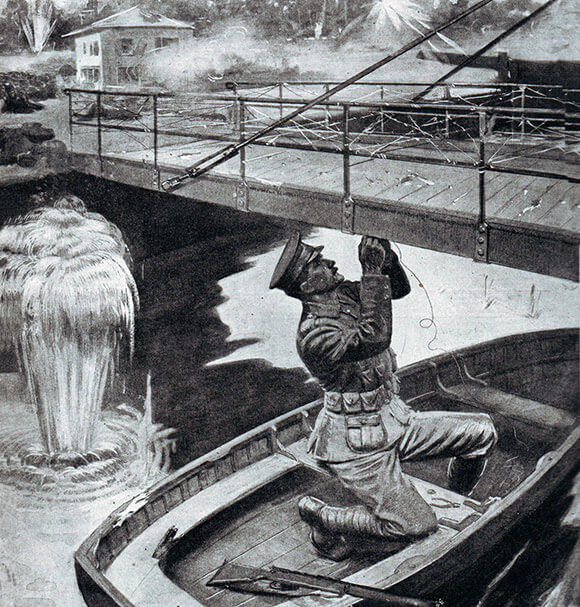
Lance Corporal Charles Jarvis, of 57th Field Company Royal Engineers, preparing the demolition of the bridge at Jemappes, for which he received the Victoria Cross: Battle of Mons on 23rd August 1914 in the First World War
At Mariette, Captain Wright RE persisted in trying to destroy the bridge although seriously wounded, winning himself a Victoria Cross. Companies of the Northumberland Fusiliers hung on to cover Wright’s attempts.
At around 5pm the German IV Corps came up and attacked the 19th Brigade on the western end of the canal line.
Along the line the British regiments withdrew as the Germans pressed their attack, bringing up bridging pontoons to cross the canal.
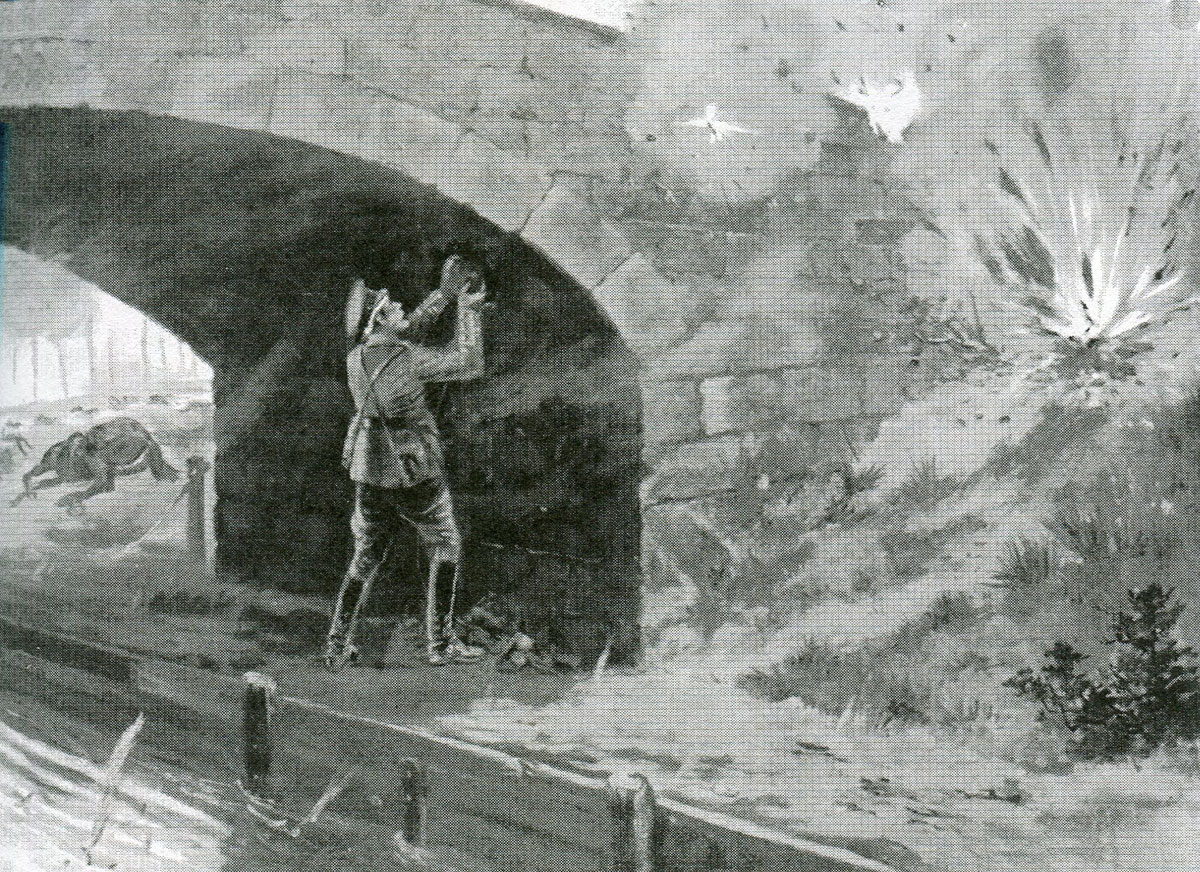
Captain Wright placing explosives under the bridge at Mariette in the Battle of Mons on 23rd August 1914 in the First World War: picture by G.D. Rowlandson
On the right the Middlesex and RIR experienced considerable difficulty in extricating themselves from the salient as German infantry were infiltrating through Mons to the open country south of the city. A strong German attack on the Gordons and Royal Scots on the Bois la Haut was repulsed with heavy German losses. Behind the high ground German infantry advancing through Mons ambushed the withdrawing 23rd Battery RFA, but were driven off.
Finally the German army command decided to let the British withdraw without further interference and bugles sounded the ‘Cease Fire’ along the German line, much to the surprise of the British.
During the night the 2 corps of the BEF fell back to their new positions. The 8th Brigade extricated itself from the canal salient and withdrew without further interference from the Germans.
Initially II Corps fell back to the line Montreuil-Wasmes-Paturages-Frameries during the evening. In the early hours of the 24th August the order was issued to II Corps to continue the withdrawal to the Valenciennes to Mauberge road, running west to east 7 miles to the south of the Mons Canal (at the bottom of the map to the south of Bavai).
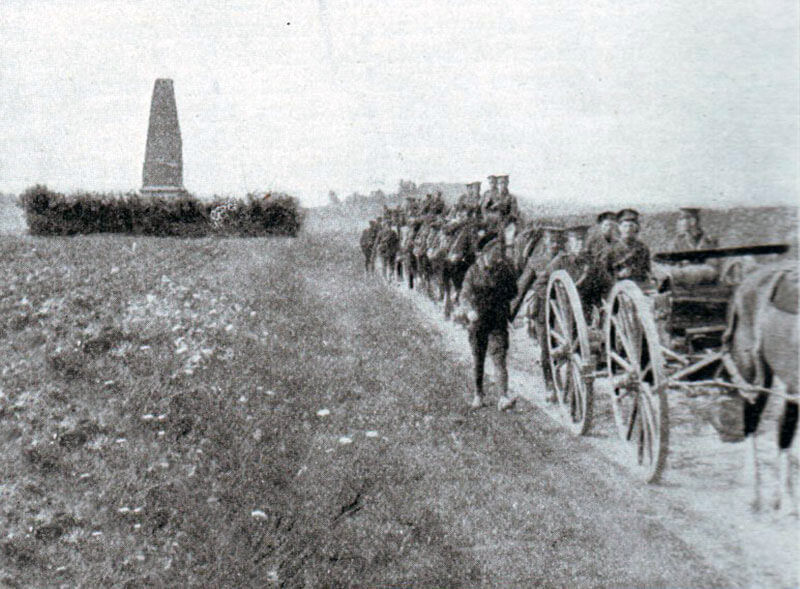
British transport passing the memorial to the Battle of Malplaquet, fought by the Duke of Marlborough on 11th September 1709 to the south of Mons, during the retreat: Battle of Mons on 23rd August 1914 in the First World War
The need for this withdrawal was not easily understood by the British troops who considered that they had seen off the German attacks, but was necessary for the BEF to conform to the French Fifth Army on its right and to avoid encirclement by the German corps moving south on their left.
This withdrawal was the beginning of the ‘Retreat from Mons’ which ended south of the Marne on 5th September 1914.
Casualties in the Battle of Mons:
British casualties were thought on the day to be much greater than in fact they were. This was due to the intense artillery fire on the British line, giving the expectation of high casualties, and to the confused nature of the withdrawal. Platoons and companies became separated during the night, rejoining their parent battalions hours later or during the next day. Total British casualties of the day’s fighting were around 1,500 killed wounded and missing. The casualties were suffered by II Corps and by 3rd Division in particular. The 4th Middlesex and the 2nd Royal Irish Regiment suffered around 450 and 350 casualties respectively.
German casualties are unknown with accuracy but are thought to have been around 5,000 killed, wounded and missing from the fighting along the Mons Canal Line.
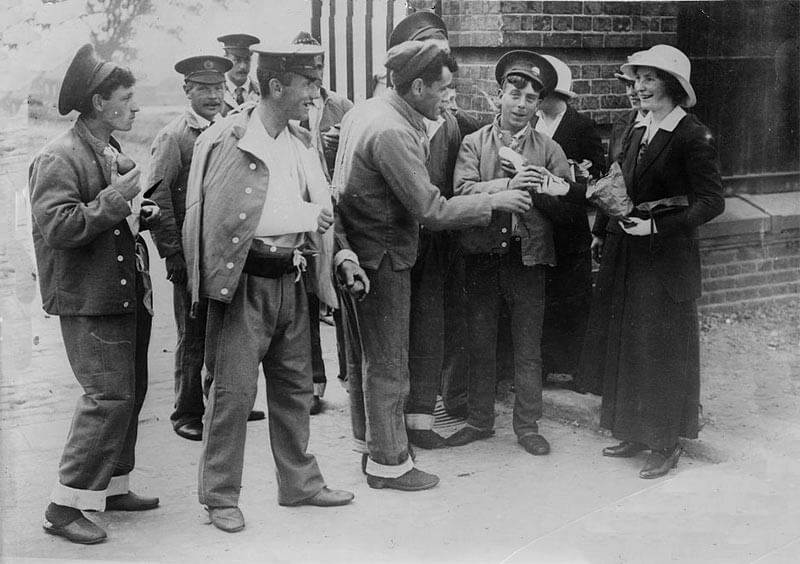
Wounded soldiers from the Battle of Mons back in ‘Blighty’: Battle of Mons on 23rd August 1914 in the First World War
Aftermath to the Battle of Mons:
The BEF retreated in compliance with Lanrezac’s French Fifth Army on their right. The retreat continued until 5th September 1914, when the French counter-attack from Paris took place on the Marne and the Allied armies turned and pursued the Germans to the line of the Aisne River.
The actions of the BEF in the various incidents are described in the next sections.
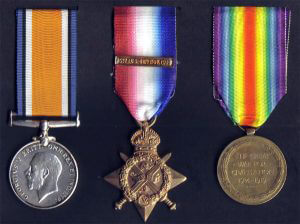
‘Pip, Squeak and Wilfred’: The 1914 Star (in the centre), the British War Medal and the Victory Medal awarded to Private Conway, 1st Battalion the Cheshire Regiment: Battle of Mons on 23rd August 1914 in the First World War
Decorations and campaign medals:
The 1914 Star was issued to all ranks who served in France or Belgium between 5th August 1914, the date of Britain’s declaration of war against Germany and Austria-Hungary, and midnight on 22nd/23rd November 1914, the end of the First Battle of Ypres. The medal was known as the ‘Mons Star’. A bar was issued to all ranks who served under fire stating ‘5 Aug. to 23 Nov. 1914’.
An alternative medal the 1914/1915 Star was issued to those not eligible for the 1914 Star.
The 1914 Star with the British War Medal and the Victory Medal were known as ‘Pip, Squeak and Wilfred’. The British War Medal and the Victory Medal alone were known as ‘Mutt and Jeff’.
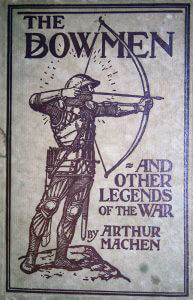
The book ‘The Bowmen’ by Arthur Machen, the origin of the ‘Angel of Mons’ myth: Battle of Mons on 23rd August 1914 in the First World War
Anecdotes and traditions from the Battle of Mons:
- Walter Bloehm, a reserve officer in the German 12th Brandenburg Grenadier Regiment which suffered heavy losses in its attack against 1st Royal West Kent’s at St Ghislain, wrote in his memoir entitled ‘Vormarsch’: ‘Our first battles is a heavy, unheard of heavy defeat, and against the English, the English we had laughed at.’
- The Angel of Mons: In September 1914 a journalist, Arthur Machen, published in the Evening Standard newspaper a story called ‘The Bowmen’ in which archers from the time of the Battle of Agincourt in 1415 assisted the British troops at Mons. The story was re-printed in parish magazines across Britain. The story gave rise to the legend, widely accepted as true, that there was angelic intervention on behalf of the British at Mons.
- Lieutenant Maurice Dease, the machine gun officer of 4th Royal Fusiliers received a posthumous Victoria Cross for his actions in assisting in the defence of the 2 bridges at Nimy in the Mons Canal Salient on 23rd August 1914.
- Private Sidney Godley was one of the gunners in Lieutenant Dease’s machine gun section. Godley continued to work his gun at the Nimy bridges, although wounded, remaining in action while the rest of his battalion withdrew. Unable to move, Godley was taken to Mons Hospital by local civilians where he was captured by the Germans. He was awarded the Victoria Cross, presented to him by King George V in 1919 after his release from prison camp.
- Captain Theodore Wright, Royal Engineers, received a posthumous Victoria Cross, in part for his repeated but unsuccessful efforts to ‘blow’ the bridge at Mariette. The 2 field companies of the Royal Engineers of which Wright was the adjutant, the 56th and 57th, were given the responsibility of destroying 10 to 12 bridges across the Mons Canal. Due to the closeness of overwhelming numbers of German troops only 1 bridge, at Jemappes, was destroyed. Wright died after being severely wounded on the Aisne on 14th September 1914.
- Lance Corporal Charles Jarvis, Royal Engineers, a member of 57th Field Company achieved the destruction of the bridge at Jemappes and received the Victoria Cross.
References for the Battle of Mons:
Mons, The Retreat to Victory by John Terraine
The First Seven Divisions by Lord Ernest Hamilton
The Official History of the Great War by Brigadier Edmonds August-October 1914
The previous battle in the First World War is the British Expeditionary Force (BEF)
The next battle in the First World War is the Battle of Mons (2nd Day): Elouges
